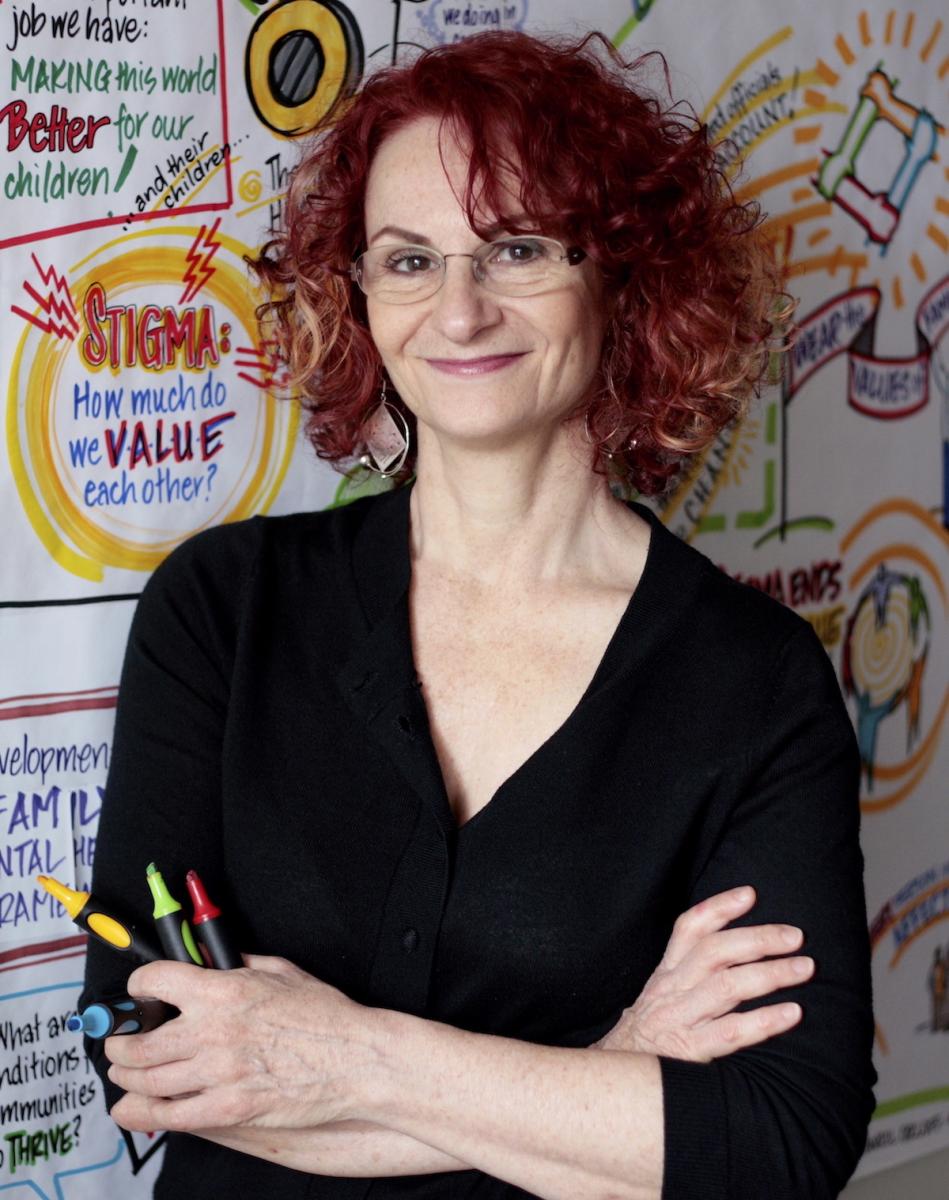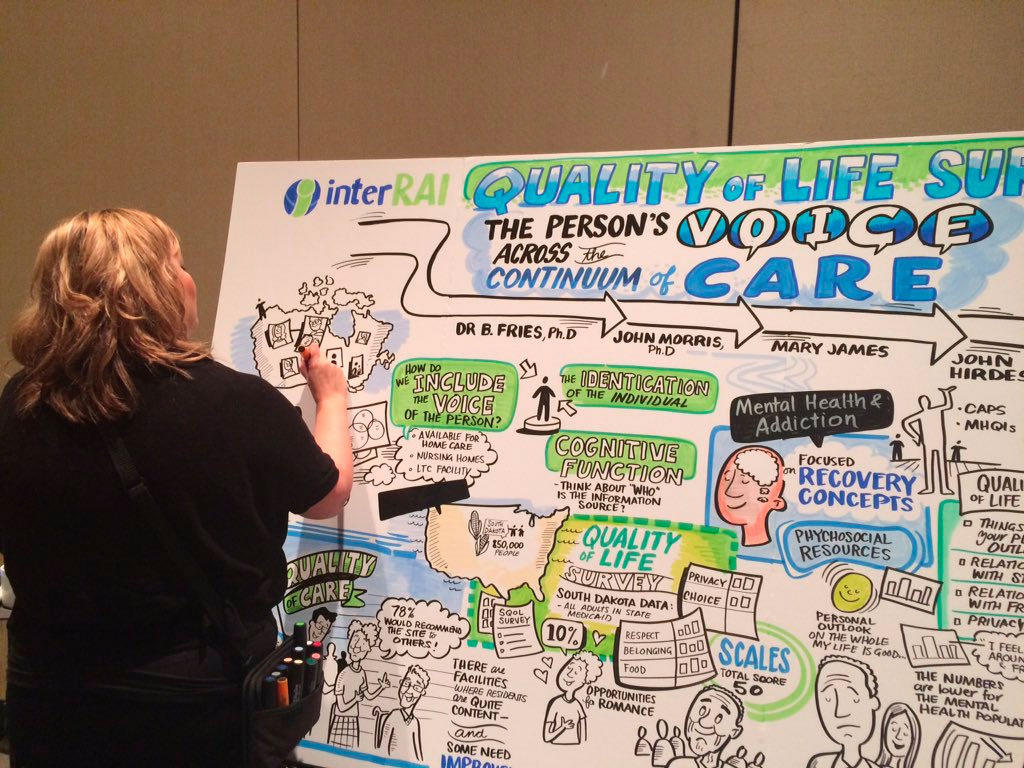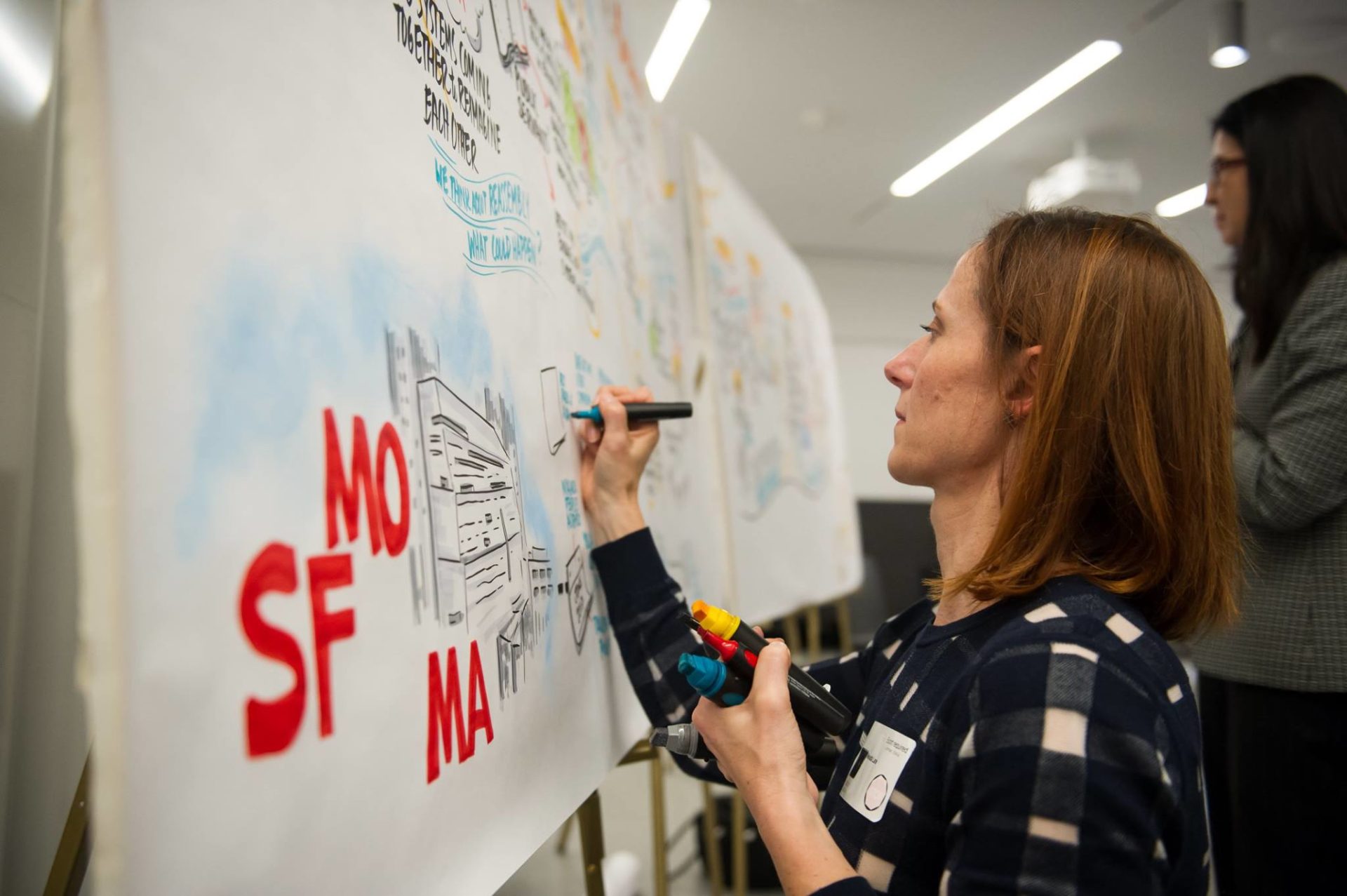
2017 Trends in Graphic Recording
It’s time for the annual wrap-up from some of my closest graphic facilitation and graphic recording colleagues.
Last year, we shared what we noticed about about human nature or communication (because we’re at hundreds of meetings!). This year, the questions are a little harder. Consider the work of visual practitioners we admire: how do they work? What are they doing differently? What do we notice? Secondly, what’s the one thing the field of visual practice needs to do next – but is avoiding?
Here’s why these questions are important.
When people see a beautiful graphic recording image, they’ll often say to us, “that’s so pretty”. Which is very kind, but at the same time – what if it’s a pretty picture of the wrong conversation?
The visual practice field has matured enough to look beyond the “pretty” in our work. It’s great to congratulate each other on a job well done, but we also need to make more room for the critical, the intangible, and the process behind our work – as a way for our industry to challenge itself and effectively grow. Making space for this conversation will help us meet our challenges head-on. Let’s talk about process and not just the end product.
This year’s questions were inspired by Julie Gieseke and Anthony Weeks, and I’m looking forward to hearing your additions in the comments.
CONSTANTLY ASSESS VALUE
“I admire practitioners who are working on bringing visual tools and methods to industries and fields that we don’t (yet) think of as visual to transform how work gets done.
“I see that the field needs to be less self congratulatory. Not all graphic Recording is helpful or “amazing”! We need to really ask how and where we can really bring value to clients.”
– Nevada Lane – Lane Change Consulting
ASK QUESTIONS ABOUT THE VALUE OF OUR WORK

“I admire practitioners who are delving deeper into their practice, asking hard questions about the value of our work, what it means to partner effectively with our clients, how our work fits into large frameworks of complexity and systems thinking, and how we can truly serve organizational and social transformation. These are the questions that are working me right now, and I gain nourishment from others who are further along the road that I am.”
– Avril Orloff – http://outsidethelines.ca/
PRACTICE PROFESSIONALISM

“Professionalism is important in our field — professionalism in how we position graphic facilitation / recording, in how we present ourselves at events, and in how we contract / license our work. Another layer to this is encouraging each other to develop expertise in certain industries, types of events, or formats.
“I admire colleagues who are carving out niches and exploring new ways of applying graphics rather than one-size-fits-all. This pushes our industry to innovate and evolve!”
– Tanya Gadsby – Drawing Out Ideas
DE-PRIVILEGE THE PRETTY, EMBRACE THE UGLY
 “As the field expands I admire professionals who are strategic about what organizations they reduce rates for, particularly those thinking of what they want to do in their own future work. There should always be a rationale for a rate lower than the local average.
“As the field expands I admire professionals who are strategic about what organizations they reduce rates for, particularly those thinking of what they want to do in their own future work. There should always be a rationale for a rate lower than the local average.
“I see that the field needs to really encourage creative new approaches, dialogic processes, methods, materials and facilitators from new places, so that distinctiveness of each of our works is a priority. We ourselves need to de-privilege the pretty and embrace the ugly so that our clients are more likely to.”
– Aaron Johannes – Imagine a Circle
BE HONEST ABOUT WHAT WE VALUE
“I admire practitioners who put listening, service, synthesis, and clarity at the center of their work. Yes, I love beauty. Yes, I love imagination. Yes, I love technical proficiency in drawing…AND it’s NOT all about the beauty of the picture or image. It’s about the utility and meaning-making of the image. The field, as a whole, needs to get more honest about what we value.”
– Anthony Weeks @weeksonian
ENVISION NEW USES AND SETTINGS FOR GRAPHIC FACILITATION

“I admire practitioners who are delving into new areas that can benefit from graphic facilitation. For example, I’ve seen some interesting work with family mediation, mapping a personal journey, life coaching, and working with at-risk youth. There are so many ways that we can inject some creativity and connectedness within these conversations, and I think the opportunities are endless.”
– Liisa Sorsa – Think Link Graphics
PUT THE TIME INTO RELATIONSHIPS

“I admire the practitioners who have long-term relationships with trusted clients, and want to see the field grow in this direction. Not all visual practitioners are interchangeable – and we shouldn’t pretend we are, even if our handwriting matches. When we reach out for feedback about the images from the group and don’t hear anything – or if they just say things look ‘amazing’ – what we’re missing is trust. Everything changes for the better when it’s a two-way relationship.”
– Sam Bradd, Drawing Change
LEGITIMIZE VISUAL PRACTICE

“I admire practitioners who are working on the legitimization for our profession. We provide a valuable service that clients are still learning to discern. Educating our clients about the value we bring to groups can be challenging and the more white papers, studies, and well-researched and thought out articles help justify why every meeting should include a visual practitioner. Developing the science and “academics” behind it is a step towards true legitimization and I am deeply grateful to those individuals.”
– Sunshine Benbelkacem – That Girl Shines
ENGAGE IN SELF-REFLECTION

“I admire practitioners who engage in self reflection to deepen, stretch and improve their work on all levels. Not just drawing & lettering, but in their listening, in being present, in questioning their assumptions and biases. And in showing up authentically, being open to learning.”
– Emily Shepard – The Graphic Distillery
CONNECT THROUGH A SHARED COLLECTIVE VISION

“In our fast-paced, complex world, it’s no coincidence the field of visual practitioners has grown. Something we’re avoiding is finding our story as a collective visual field. What’s our vision? What values do we share? Should EUVIZ and IFVP join forces? As a Professional Coach, a similar conversation happened that resulted in the creation of the International Coaching Federation. I hope our visual field can find our collective vision too.”
– Yiely Ho
VALUE LISTENING AS WELL AS ILLUSTRATION

“I admire people who are thought partners for their clients and consider themselves designers that deliver an experience, as opposed to a vendor that delivers a service. I also admire people who are looking at the outer edges of our practice and thinking about what’s next for us as a field, particularly with the rapid advent of tech tools (Jamboard by Google, hand drawn sketch animation software, drag and drop apps, etc.) that will inevitably “replace” some of the work we do.
“I would like to see our field place equal collective value on work that demonstrates deep listening in service to a group and its process as it does on highly illustrative drawing.”
– Giselle Chow – Giselle Chow Consulting
___________
Let’s continue these conversations into 2018, not just online but also in real life! Two ways we can do this are: meet up with me at the EuViz conference in Denmark this July 31 – August 2, 2018, or consider joining Sophia Liang and I for the Beyond the Basics workshop February 11 – 13, 2018 in Portland.
In the meantime, a happy and healthy holiday time to you and yours!

